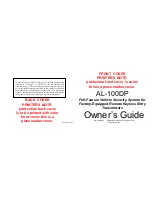
INSTALLATION SHEET
1165/1165H/1165HS Wireless Commercial Smoke Detectors
Description
The Model 1165 Smoke Detector, 1165H Smoke/Heat Detector, and 1165HS Smoke/Heat Detector with Sounder are
photo electric, wireless detectors used with the 1100X Series Wireless Receivers.
Features
• Tamper switch
sends a trouble signal to the control
panel when the detector is removed from the
mounting base.
•
Optional integrated fixed 135°F temperature and
rate of rise heat detector trips an alarm based on
temperature detected.
Included Components
• One 1165 Smoke Detector with DMP wireless
transmitter installed
OR
• One 1165H Smoke/Heat Detector with DMP wireless
transmitter installed
OR
• One 1165HS Smoke/Heat Detector with Sounder
with DMP wireless transmitter installed
AND
• Two 3V lithium Panasonic CR123A (DMP part number CR123-FIRE) batteries
• Hardware pack
Programming the Transmitter in the Panel
Program the device as a zone in
Zone Information
during panel programming. At the Serial Number: prompt, enter
the eight-digit serial number. Set supervision time to 3. Continue to program the zone as directed in the panel
programming guide.
Note
: When a receiver is installed, powered up, or the panel is reset, the supervision time for transmitters is reset.
If the receiver has been powered down for more than one hour, wireless transmitters may take up to an additional
hour to send a supervision message unless tripped, tampered, or powered up. This operation extends battery life for
transmitters. A missing message may display on the keypad until the transmitter sends a supervision message.
Transmitted Signal Outputs
The smoke detector provides the signals listed in the table:
Signal
Keypad Display
Alarm
ALARM
Alarm restore
OK
Low battery
LOBAT
Selecting the Proper Location (LED Survey Operation)
The 1165/1165H/1165HS Transmitter provides a survey capability to allow one person to confirm transmitter
communication with the receiver. The 1165/1165H/1165HS Transmitter PCB Red Survey LED turns on whenever data
is sent to the receiver then immediately turns off when the receiver acknowledgement is received. Pressing the test
button is a convenient way to send data to the receiver to confirm operation. The transmitter survey LED can be
seen around the test button location. When the transmitter does not receive an acknowledgement from the receiver
the LED remains on for about 8 seconds to let you know communication is not established. Communication is also
faulty when the LED blinks multiple times in quick succession. Relocate the transmitter or receiver until the LED
immediately turns off indicating the transmitter and receiver are communicating properly. Proper communication
between the transmitter and receiver is verified when for each press or release of the test button, the LED blinks
immediately on and immediately off. Repeat this test to confirm five separate consecutive LED blinks. Any indication
otherwise means proper communication has not been established.
Figure 1: Smoke Detector Features
LED
Sounder Vent
Optional Heat Sensor
Optional Heat Sensor
Test Button


























